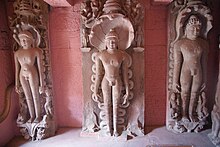History
Parshvanatha, the twenty-third tirthankara, was born in Benaras (now Varanasi) in 872 BCE. According to Jain tradition, Kashi (now Varanasi) is the birthplace of three more tithankaras, namely Suparshvanatha, Chandraprabha and Shreyansanatha. [4]
According to Jain tradition, five tirthankaras were born at Ayodhya, including Rishabhanatha, [5] Ajitanatha, [6] Abhinandananatha, [7] Sumatinatha [8] and Anantanatha. [9]
The famous naked male torso found at Lohanipur, whether Mauryan or, more likely Kushana, is generally taken as indicative evidence of ascetic tradition in north India. Inscriptions from the many ayagapatas of the Mathura region make clear that puja to the tirthankaras with lay and ascetic involvement was an important dimension to this.
The earliest archeological evidence is in the form of a naked headless torso discovered in 1937 near Patna (Bihar), which is called the Lohanipur Torso. This has been dated by modern scholarship to about the 2nd-century BCE. It is a highly polished stone artwork of precise human form, but it is unclear if it belongs to Jainism, Ajivikas or some other Indian religious ascetic tradition. While it is not Buddhist, and is naked like the Jinas, it may also not be a Jain statue because it lacks the Jain iconography, and because similar high quality Jain artworks are missing for many centuries and Jain artworks that have been found from the same period in north India show quite different forms and symbols. It may belong to Ajivikas or another ancient Indian naked ascetic tradition. Ancient naked terracotta statues discovered in 1970s near Ayodhya are similar to the Lohanipur Torso, but terracotta arts are also missing in Jaina tradition and the Ayodhya terracotta statues too lack Jain iconography.
Shravasti is often mentioned in Jaina sources. It is also called Chandrapuri or Chandrikapuri or Ārya Kṣetra, because Jaina texts state that two of their Tirthankaras were born here millions of years ago, in prehistoric times – Sambhavanatha (3rd of 24) and Chandraprabha (8th of 24). Sravasti is also known as the capital city of Kunala's kingdom. [13]
Sambhavanatha is said to have had taken initiation, donated all his belongings, and broken his first fast in Sravasti after begging for alms from King Surendradatta. [14] [15] Munisuvrataswami, the 20th Tirthankara, visited Sravasti and initiated several members of the royal family. As per the Jaina text Jnatadharmakathah, Parshvanatha, the 23rd Tirthankara, also visited Sravasti and inspired several lay-followers to accept initiation.
Further, Shravasti is the place of the bitter arguments and meeting between Mahavira – the 24th Tirthankara, and Gosala Mankhaliputta – the founder of Ajivikas and a rival. According to the Jain texts, the Mahavira visited Shravasti many times and spent his tenth varsha monsoon season here before attaining omniscience. He was hosted by a wealthy merchant named Nandinipriya. Ancient Jain scholars such as Kapila, Maghavan and Keshi studied in Shravasti. At Sravasti, Jamāli, Mahavira's son-in-law, created the first of the eight heretical sects by opposing tenets of Jainism as taught by Mahavira himself. The eighth heretical sect, Digambara sect, was created by Sivabhuti at Rathavirapur. [17] As described in the Jaina text Uttaradhyayana Sutra, the discussion between Keśiśramanācharya and Mahavira's first disciple, Gautama Swami, is said to have had taken place at Sravasti. This was the place where Upkeśa Gaccha was established by Keśiśramanācharya after he accepted Mahavira's conduct and became a white-clad monk along with all his disciples who were initially following Parshvanatha's conduct. [18] Moreover, the Pattavali described in the Kalpa Sūtra, states the existence of "Śrāvastikā Śākhā", one of the four branches of the "Veṣavāṭikgaṇa" of the Jaina sangha. It had originated from Ācārya Kāmardhi, a disciple of Ācārya Suhastisuri, belonging to the beginning of the 3rd century BCE. [19] Ācārya Jinaprabhasuri, in his Vividha Tirtha Kalpa confirms that a Jaina temple with an image of Sambhavanatha was renovated multiple times until it was finally completely desecrated during the reign of Alauddin Khilji. [20]
This page is based on this
Wikipedia article Text is available under the
CC BY-SA 4.0 license; additional terms may apply.
Images, videos and audio are available under their respective licenses.
















